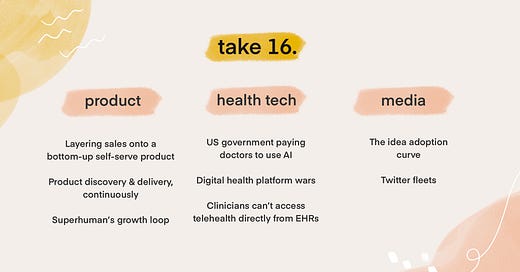Take 16. Layering sales onto self-serve; paying doctors to use AI; the idea adoption curve
Welcome to this week’s Double Take on product, health tech, and digital media.
We’re less than 5 weeks away from the New Year. One of the more positive and exciting happenings this year is the acceleration of consumer technologies: remote work platforms (Zoom, Asana), food & grocery delivery (Instacart, Doordash), telehealth & consumer health (One Medical, Teladoc/Livongo), travel (AirBnB), and consumer social (TikTok, Roblox, Discord). (Links are for S1 filings). Nikhil’s latest newsletter provided an excellent summary of the trends in consumer tech and what to anticipate in the coming years.
For Marty Cagan fans, Dan Olsen is hosting him on Dec 3rd to talk about “Product leadership is hard” and share advice from his new book, Empowered.
Now onto the regular programming 👇
💻 Product
Layering sales onto a bottom-up self-serve product. While bottom-up/self-serve products are all the hype these days, Pete’s primer explains how and when to layer in direct sales to drive significant growth. Adding salespeople can facilitate penetration into an organization that started using the product, by helping smooth over complex use cases. Sales can also grow conversion rate of the self-serve offer, by helping user successfully achieve their goal in the product. The general rule is, a salesperson should deliver 4x their fully loaded cost in incremental revenue.
Product discovery & delivery, continuously. Marty Cagan explains why every person on the product team needs to be engaged in both discovery and delivery activities. It’s critical for empowerment and innovation, to avoid one party obtaining the learning then hand off to another to execute on requirements. (Here’s an interesting debate between this approach and Ryan Singer’s Shape Up method.)
Superhuman’s growth loop. Productivity and collaboration tools like Figma and Zoom has an inherent network effect because they require others to use it to produce utility. Superhuman is an outlier. It’s built on top of email clients and can be used regardless of what email clients the other users are using. However, Superhuman has incredible word of mouth acquisition and a high touch onboarding experience. It’s growth acquisition loop is driven by social capital, not personal utility. High touch onboarding —> get valuable customer feedback to strengthen product —> build word of mouth to grow reach.
📠 Health Tech
The US government will pay doctors to use AI. CMS announced it would pay for the use of two AI systems. ContaCT is a software that can alert a neurosurgeon when it recognizes stroke in patient’s CT scan. IDx-DR can analyze photos of the retina to diagnose diabetic retinopathy. Both products have been FDA approved. Even so, the eye exams are reimbursed at a much lower rate than the brain scans. Physicians expressed that the reimbursement have to be increased in order to make economical sense to screen more patients.
Digital health’s platform wars are heating up. The 3 pillars of today’s digital health platforms are: technology backbone, consumer experience, and clinical expertise. The technology infrastructure and building blocks, such as patient data exchange, has been built over the years, lowering barrier to entry for new companies. As consumer expectations grow, consumer experience is getting prioritized across DTC brands, care management platforms, and retail players. New entrants to healthcare will likely partner or buy to acquire the clinical expertise in order to win.
Most clinicians can't access telehealth directly from EHRs. Most clinicians report positively on the use of telehealth on patient outcome, costs, and professional satisfaction. However, almost 60% said they can’t access telehealth directly through their electronic health records, due to lack of integration and technical support.
📣 Media
The idea adoption curve. With the consolidation of meda (Buzzfeed acquires Huffpost), Ben Thompson mapped “idea adoption” to the “technology adoption” curve in Geoffrey Moore’s Crossing the Chasm. The left side of the curve lies visionaries whose focus is generating new ideas, with a goal of influencing the mass market, not monetizing it. The right side of the curve lies players like Buzzfeed, whose focus is mass distribution rather than new ideas. It relies on scale to monetizing its ad model.
Twitter fleets. Twitter launches story format “fleets”, ie. fleeting thoughts. So far, 99% of content I see are photos of pets, places, and screenshots. It’s not what I use Twitter for, but the more personal element is interesting (and confusing too). There are way too many platforms to consume content aimlessly. Our thumbs are getting comfortable tapping away rather than connecting with the brain to actually create.




